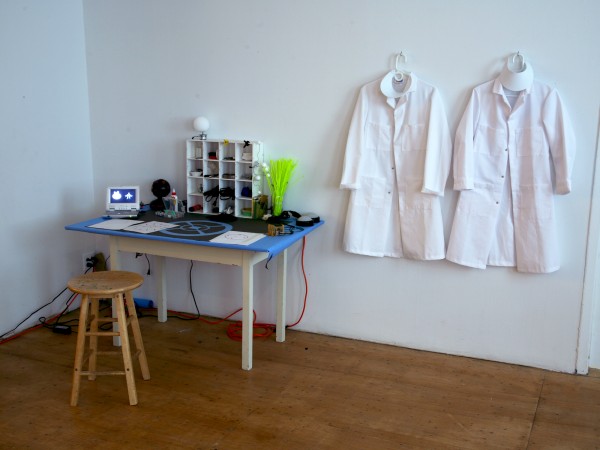Whilst in residence during the autumn of 2006, Manon de Pauw and Michel Forest transformed the gallery space into a studio, thereby enabling the public to see both the objects that they used to create their images and the end result. The two artists baptized the studio that they had made fabricated from cardboard and paper, The Little Factory of Time. In it, they produced a series of exploratory video/graphic works that played with the mechanisms of clocks and those of the video image. The residency also offered Manon de Pauw the opportunity to pursue her ludic investigation into video/graphic art in a collaborative setting.
Together, Manon de Pauw and Michel Forest created a comprehensive setting for the videos in which they appear in a universe of black and white (although filmed in color). The videos evoke both the origins of cinema and early experimental films, as well as the beginning of the television era. The two artists fabricated paper clocks, circles, spirals, dials made from cardboard, and an hourglass; a variety of objects and symbols serving as the pretext for a range of games. The videos, which themselves became markers of time, were presented in a variety of ways: on mini monitors, on television screens, or else projected on the wall.
The artists explain that, The Little Factory of Time considers the “acceleration of the rhythm of our lives”, whilst also acting as a site in which to explore the specific temporality of the moving image. During the residency, the public had the opportunity to invent their own games on a table installed in the ephemeral studio. The situation was both interactive and instructive. Video footage showed the artists in the process of exchanging rectangular pieces of cardboard (hours), seated around the same table (the dial). This method of video making, employing paper cutting, is very close to bricolage and drawing. The range of studio games, with their explicit references, tended towards abstraction, in that they appear to concern formal rather narrative concerns.
Video art as fine/visual art
Since 2000, Manon De Pauw has been developing video works in the mindset of a fine/visual artist. This approach is heightened by her use of low-tech video production means, often involving bricolage with paper and performances staged by the artist in her studio. In Replis et articulations (2004), we see De Pauw drawing motifs that form images. In the video Au Travail (2003), the artist is stretched out on the floor on a bed consisting of sheets of paper.
The ways in which she produces images and presents her video footage always takes into consideration the range of modalities for disseminating imagery (whether projecting onto the floor, the wall, or on a range of screen structures)
The variety of means that that she employs to present her videos corresponds with, and reflects, her imagery, which serves to distance us from the factual content of the filmed images. Thus, the critical dimension of Manon De Pauw’s videos operates on two levels, in terms of both the shaping and the dissemination of images, shedding light on two fundamental aspects of video art. De Pauw’s video works could be viewed as portraits of the artist in her studio. But there is more to her work than this. In the majority of her works, the artist presents herself both as a symbol and the producer of symbols. She is both a line and a point, the tracer of the line and the tracer of the point, accentuating the significance and relativism of signs. The colors (primarily black and white), symbols, gestures and bodies in her work have a generic character. Given that the artist uses her body as one symbol amongst many, she avoids her work becoming a narcissistic representation of her various states of mind, whilst this aspect is not entirely excluded. The existential exploration in play in her work in fact concerns the question of studio practice, and the relationship between an artist and his/her work. Perhaps one of the strengths of Manon De Pauw’s work is that it considers the means of both producing and presenting video imagery, playing on both depth and surface. The artist is both subject and object. In this sense, one might say that she acts as her own Pygmalion.

